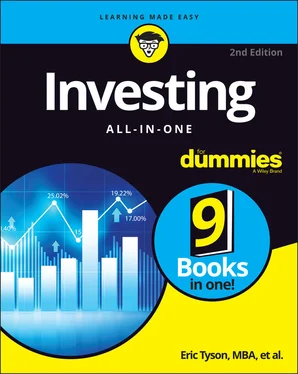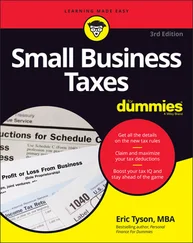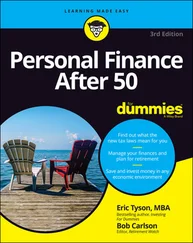Eric Tyson - Investing All-in-One For Dummies
Здесь есть возможность читать онлайн «Eric Tyson - Investing All-in-One For Dummies» — ознакомительный отрывок электронной книги совершенно бесплатно, а после прочтения отрывка купить полную версию. В некоторых случаях можно слушать аудио, скачать через торрент в формате fb2 и присутствует краткое содержание. Жанр: unrecognised, на английском языке. Описание произведения, (предисловие) а так же отзывы посетителей доступны на портале библиотеки ЛибКат.
- Название:Investing All-in-One For Dummies
- Автор:
- Жанр:
- Год:неизвестен
- ISBN:нет данных
- Рейтинг книги:3 / 5. Голосов: 1
-
Избранное:Добавить в избранное
- Отзывы:
-
Ваша оценка:
- 60
- 1
- 2
- 3
- 4
- 5
Investing All-in-One For Dummies: краткое содержание, описание и аннотация
Предлагаем к чтению аннотацию, описание, краткое содержание или предисловие (зависит от того, что написал сам автор книги «Investing All-in-One For Dummies»). Если вы не нашли необходимую информацию о книге — напишите в комментариях, мы постараемся отыскать её.
Investing All-in-One For Dummies
.
Dummies
Investing All-in-One For Dummies
Investing All-in-One For Dummies
Investing All-in-One For Dummies — читать онлайн ознакомительный отрывок
Ниже представлен текст книги, разбитый по страницам. Система сохранения места последней прочитанной страницы, позволяет с удобством читать онлайн бесплатно книгу «Investing All-in-One For Dummies», без необходимости каждый раз заново искать на чём Вы остановились. Поставьте закладку, и сможете в любой момент перейти на страницу, на которой закончили чтение.
Интервал:
Закладка:
Tax considerations alone shouldn’t dictate how and where you invest your money. You should also weigh investment choices, your desire and the necessity to take risk, personal likes and dislikes, and the number of years you plan to hold the investment.
This chapter explains how the different components of investment returns are taxed. You find proven, up-to-date strategies to minimize your investment taxes and maximize your returns. Finally, you discover tax considerations when selling an investment.
Understanding Investment Taxes
When you invest outside tax-sheltered retirement accounts, the profits and distributions on your money are subject to taxation. (Distributions are taxed in the year that they are paid out; appreciation is taxed only when you sell an investment at a profit.) So the nonretirement-account investments that make sense for you depend (at least partly) on your tax situation.
Tracking taxation of investment distributions
The distributions that various investments pay out and the profits that you may make are often taxable, but in some cases, they’re not. It’s important to remember that it’s not what you make before taxes (pretax) on an investment that matters, but what you get to keep after taxes.
 Interest you receive from bank accounts and corporate bonds is generally taxable. U.S. Treasury bonds, which are issued by the U.S. federal government, pay interest that’s state-tax-free but federally taxable.
Interest you receive from bank accounts and corporate bonds is generally taxable. U.S. Treasury bonds, which are issued by the U.S. federal government, pay interest that’s state-tax-free but federally taxable.
Municipal bonds, which state and local governments issue, pay interest that’s federally tax-free and also state-tax-free to residents in the state where the bond is issued. (For more on bonds, see Book 4.)
Taxation on your capital gains, which is the profit (sales price minus purchase price) on an investment, is computed under a unique federal taxation system. Investments held and then sold in less than one year at a profit generate what is called short-term capital gains, which are taxed at your normal marginal income tax rate (which is explained in the next section).
Profits from investments that you hold longer than 12 months and then sell at a profit generate what are called long-term capital gains. Under current tax law, these long-term gains are taxed at a maximum 20 percent rate, except for most folks in the two lowest income tax brackets: 10 percent and 12 percent. For these folks, the long-term capital gains tax rate is 0 percent (as in nothing). Dividends paid out on stock are also taxed at the same favorable long-term capital gains tax rates under current tax law.
The Patient Protection and Affordable Care Act (informally referred to as Obamacare) increased the tax rate on the net investment income for taxpayers with adjusted gross income above $200,000 (single return) or $250,000 (joint return). Net investment income includes interest, dividends, and capital gains. The increased tax rate is 3.8 percent.
Determining your tax bracket
Many folks don’t realize it, but the federal government (like most state governments) charges you different income tax rates for different parts of your annual income. You effectively pay less tax on the first dollars of your earnings and more tax on the last dollars of your earnings. As a wage earner receiving a paycheck, you won’t actually notice or see your actual tax rate rising during the year. The reason: Taxes are withheld at a constant rate from your paycheck based upon estimating your expected income for the year and your total expected tax bill for the year.
Your federal marginal income tax rate is the rate of tax that you pay on your last, or so-called highest, dollars of income (see Table 2-1). Your taxable income is the income that is left after taking allowed deductions on your return.
TABLE 2-12021 Federal Income Tax Rates for Single and Married Households Filing Jointly
| Federal Income Tax Rate | Singles Taxable Income | Married Filing Jointly Taxable Income |
|---|---|---|
| 10% | Up to $9,950 | Up to $19,900 |
| 12% | $9,951 to $40,525 | $19,901 to $81,050 |
| 22% | $40,526 to $86,375 | $81,051 to $172,750 |
| 24% | $86,376 to $164,925 | $172,751 to $329,850 |
| 32% | $164,926 to $209,425 | $329,851 to $418,850 |
| 35% | $209,426 to $523,600 | $418,851 to $628,300 |
| 37% | Over $523,600 | Over $628,300 |
Your actual marginal tax rate includes state income taxes if your state levies an income tax. Though this chapter focuses on the federal income tax system and strategies to reduce those taxes, most of what is discussed also helps you reduce your state income taxes, which the vast majority of states levy. Each state income tax system is unique, so covering them all here is impossible. All but eight states — Alaska, Florida, Nevada, South Dakota, Tennessee, Texas, Washington, and Wyoming — impose a state income tax. (New Hampshire has only a state income tax on dividend and interest investment income.)
 There’s value in knowing your marginal tax rate. This knowledge allows you to determine the following (among other things):
There’s value in knowing your marginal tax rate. This knowledge allows you to determine the following (among other things):
How much you could reduce your taxes if you contribute more money to retirement accounts
How much you would pay in additional taxes on extra income you could earn from working more
How much you could reduce your taxable income if you use investments that produce tax-free income (which may make sense only if you’re in a higher tax bracket — more on this later in the chapter)
Devising tax-reduction strategies
Use these strategies to reduce the taxes you pay on investments that are exposed to taxation:
Make use of retirement accounts and health savings accounts. Most contributions to retirement accounts gain you an immediate tax break, and once they’re inside the account, investment returns are sheltered from taxation, generally until withdrawal. Think of these as tax reduction accounts that can help you work toward achieving financial independence. See Chapter 1in Book 2 for details on using retirement accounts when investing.Similar to retirement accounts are health savings accounts (HSAs). With HSAs, you get a tax break on your contributions up-front; investment earnings compound without taxation over time; and there’s no tax on withdrawal so long as the money is used to pay for health-related expenses (which enjoy a fairly broad list as delineated by the IRS).
Consider tax-free money market funds and tax-free bond funds. Tax-free investments yield less than comparable investments that produce taxable earnings, but because of the tax differences, the earnings from tax-free investments can end up being greater than what taxable investments leave you with. If you’re in a high-enough tax bracket, you may find that you come out ahead with tax-free investments. For a proper comparison, subtract what you’ll pay in federal and state income taxes from the taxable investment income to see which investment nets you more.
Invest in tax-friendly stock funds. Mutual funds and exchange-traded funds that tend to trade less tend to produce lower capital gains distributions. For funds held outside tax-sheltered retirement accounts, this reduced trading effectively increases an investor’s total rate of return. Index funds invest in a relatively static portfolio of securities, such as stocks and bonds. They don’t attempt to beat the market; rather, they invest in the securities to mirror or match the performance of an underlying index. Although index funds can’t beat the market, the typical actively managed fund usually doesn’t, either, and index funds have several advantages over actively managed funds.
Читать дальшеИнтервал:
Закладка:
Похожие книги на «Investing All-in-One For Dummies»
Представляем Вашему вниманию похожие книги на «Investing All-in-One For Dummies» списком для выбора. Мы отобрали схожую по названию и смыслу литературу в надежде предоставить читателям больше вариантов отыскать новые, интересные, ещё непрочитанные произведения.
Обсуждение, отзывы о книге «Investing All-in-One For Dummies» и просто собственные мнения читателей. Оставьте ваши комментарии, напишите, что Вы думаете о произведении, его смысле или главных героях. Укажите что конкретно понравилось, а что нет, и почему Вы так считаете.












